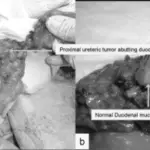Fibroepithelial polyp of the ureter is a rare benign tumor. They are an exophytic intraluminal mass of vascular connective tissue and variable inflammatory cells covered by normal urothelium.
What is the Pathology of Fibroepithelial Polyp of the Ureter?
The pathology of fibroepithelial polyp of the Ureter is:
-Etiology: The cause of fibroepithelial polyps is unclear, they are thought to be either congenital slow-growing lesions or lesions that develop as a result of chronic urothelial irritants, such as infection, inflammation, calculi, or obstruction.
-Genes involved: Gene involvement is not clear.
-Pathogenesis: The sequence of events that lead to fibroepithelial polyp remains uncertain.
-Morphology: The morphology associated with fibroepithelial polyp of the ureter shows long, smooth ureteral filling defects; their position may change between images, and they are associated with varying degrees of hydronephrosis.
-Histology: The histology associated with fibroepithelial polyp of the ureter shows loose vascular fibrous stroma with overlying benign transitional epithelium.
How does Fibroepithelial Polyp of the Ureter Present?
Patients with fibroepithelial polyp of the ureter typically affect males three times more than females in their 3rd to 4th decade of life. The symptoms, features, and clinical findings associated with the fibroepithelial polyp of the ureter include hematuria and flank pain. The pain is characteristically intermittent and colicky due to partial obstruction. Urinary frequency, dysuria, and pyuria are other less common findings. The flank pain may be attributable to either torsion or intussusception of the polyp or intermittent obstruction.
How is Fibroepithelial Polyp of the Ureter Diagnosed?
Fibroepithelial polyp of the ureter is diagnosed by intraoperative retrograde pyelogram. If a filling defect is encountered, ureteroscopy is indicated for polyp mapping.
How is Fibroepithelial Polyp of the Ureter Treated?
Fibroepithelial polyp of the ureter is treated by ureteroscopic resection.
What is the Prognosis of Fibroepithelial Polyp of the Ureter?
The prognosis of the fibroepithelial polyp of the ureter is excellent.



